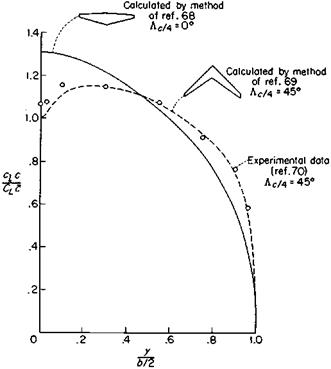Invention of the Sweptback Wing
The story of the independent invention of the sweptback wing in the United States by Robert T. Jones and in Germany by Adolph Busemann has been told many times. But some accounts of the early work on the stability and control effects of wing sweep belong to this history.
The dive pullout problems of thick, straight-wing airplanes such as the Lockheed P-38 were mainly due to a large increase in static longitudinal stability at high Mach numbers. Thus, an early theoretical result (Jones, 1946) seemed too good to be true. Jones showed that the static longitudinal stability or aerodynamic center location of sharply swept delta wings is invariant with Mach number, from zero to supersonic speeds. A test of a triangular wing of aspect ratio 0.75, with leading-edge sweep of 79 degrees, confirmed the theory. The catch turned out to be that wings of that low aspect ratio are impractical for airplanes that operate out of normal airports.
More practical swept wings for airplanes have higher aspect ratios. In moderately high – aspect-ratio-swept wings there is an outboard shift in additional span loading (Figure 11.7). The outboard shift in additional span load leads to wing tip stall at low angles of attack for moderate – to high-aspect-ratio-swept wings. Outflow of the boundary layer adds to this tendency. Wing tip stall causes an unstable break in the wing pitching moment at the stall (Figure 11.8). That is, loss of lift behind the center of gravity causes the wing (and airplane) to pitch nose-up at the stall, driving the airplane deeper into stall. On the other hand, a stable pitching moment break or nose-down pitch leads to stall recovery, provided that the elevator is moved to trim at a lower angle of attack. Tip stall also leads to an undesirable wing drop and reversal or positive signs for the roll damping derivative Clp, making spins easier to enter and sustain. A condition for autorotation in spins is a positive Clp.
The situation changes for low-aspect-ratio-swept wings, where leading-edge vortex flow acts to create diving, or stabilizing, pitching moments at the stall. A striking correlation was produced showing the combinations of wing sweep and aspect ratio that produce either stable or unstable pitching moment breaks at the stall (Shortal and Maggin, 1946). Figure
11.9 shows an extended version that includes taper ratio effects (Furlong and McHugh, 1957). The stable region was shown to be broadened for sharply tapered wings.
The McDonnell-Douglas F-4 Phantom’s wing, with aspect ratio 2.0 and quarter-chord sweep of 45 degrees, is precisely on the Shortal-Maggin stability boundary, signifying a neutral pitching moment break at the stall. High-aspect-ratio-swept wings, typical of transport
|
|
|
|
.(Ref. 10)
0 20 40 60 80 Лс/4, deg Figure 11.9 Shortal and Maggin’s celebrated empirical longitudinal stability boundary for sweptback wings, extended to include the effect of taper ratio. (From Furlong and McHugh, NACA Rept. 1339, 1957) |
airplanes, are unstable at the stall without auxiliary devices. For example, the Lockheed 1011’s wing, with aspect ratio 6.95 and quarter-chord sweep of 35 degrees, is in the unstable zone at the stall. An early attempt to evaluate in-flight the low-speed stability and control characteristics of moderate-aspect-ratio-swept wing airplanes was made by simply removing the wings of a Bell P-63 Kingcobra and reattaching them to the fuselage at a sweep angle of 35 degrees. The tail length was increased at the same time by adding a constant cross-section plug to the fuselage aft of the wing trailing edge. NACA called this early research airplane the L-39. The L-39’s first flight was made by A. M. (Tex) Johnston. He was to become famous a few years later as the test pilot for Boeing’s prototype 707 jet airliner.
Wind-tunnel tests of the L-39 showed the usual increase in dihedral effect with increasing angle of attack. That is, the rolling moment coefficient in sideslip becomes quite high in the stable direction at attitudes near the stall. There was real concern on the L-39 that if sideslip angles occurred during liftoff or the landing flare, as a result of gusts or rudder use for cross-wind corrections, the rolling moment from dihedral effects would quite overpower the ailerons and the airplane would roll out of control.
This dire possibility was part of the preflight briefing for the pilot Johnston. A briefer, one of this book’s authors (Abzug), remembers that Johnston showed no reaction and asked no questions about this, showing a bit more than the usual test pilot self-confidence. All turned out well. The L-39 flight tests were reasonably routine, and sweptback wings for the next generation of commercial and military jets were on their way.














